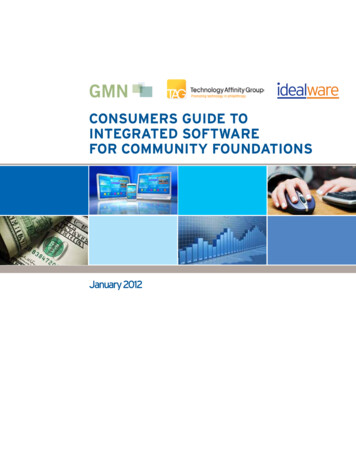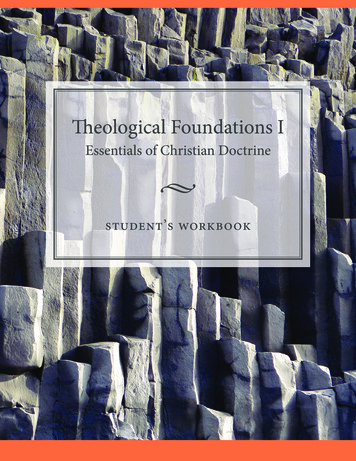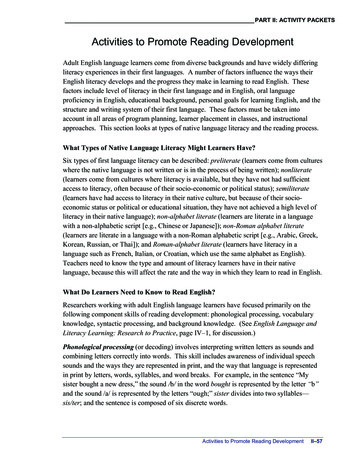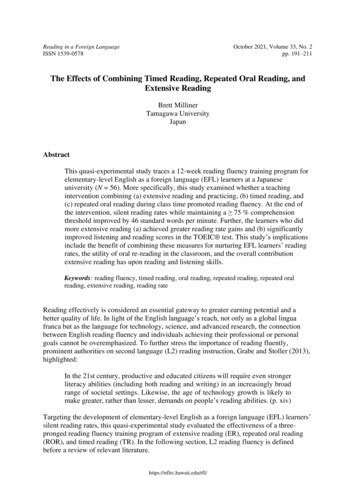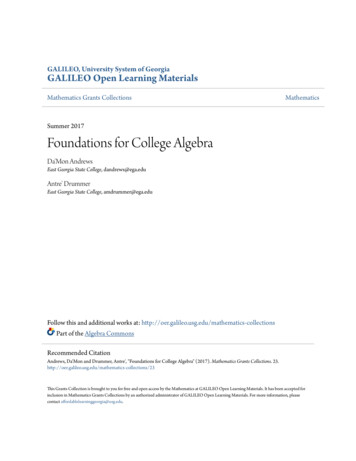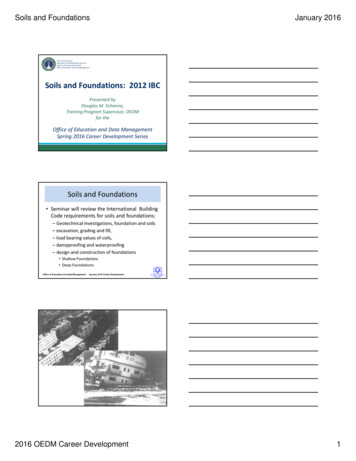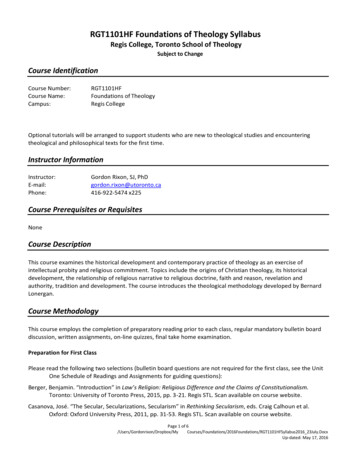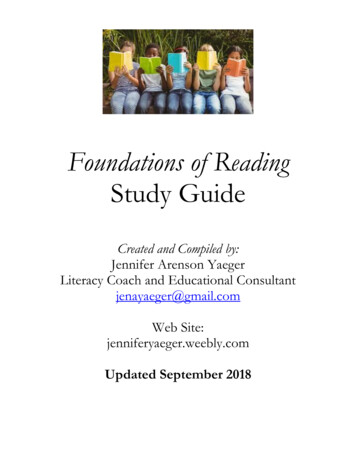
Transcription
Foundations of ReadingStudy GuideCreated and Compiled by:Jennifer Arenson YaegerLiteracy Coach and Educational Consultantjenayaeger@gmail.comWeb Site:jenniferyaeger.weebly.comUpdated September 2018
Table of ContentsOVERVIEW OF THE TEST AND RESOURCES FOR PREPARATION3FOUNDATIONS OF READING DEVELOPMENT (35% OF THE TEST)9Section 0001 Understand Phonological and Phonemic Awareness:Section 0002: Understand Concepts of Print & the Alphabetic Principle:Section 0003: Understand the Role of Phonics in Promoting Reading DevelopmentSection 0004: Understand Word Analysis Skills and StrategiesDEVELOPMENT OF READING COMPREHENSION (27% OF THE TEST)Section 0005: Understand Vocabulary Development:Section 0006: Understand How to Apply Reading Comprehension Skills and Strategies toImaginative/Literary TextsSection 0007: Understand How to Apply Reading Comprehension Skills and Strategies toInformational/Expository TextsREADING ASSESSMENT AND INSTRUCTION (18% OF THE TEST)101721333738445458Section 0008: Understand Formal and Informal Methods for Assessing Reading Development:Section 0009: Understand Multiple Approaches to Reading Instruction5968TEACHING READING TO ENGLISH LANGUAGE LEARNERS69STAGES OF READING DEVELOPMENT71INTEGRATION OF KNOWLEDGE AND UNDERSTANDING (20% OF THE TEST)76Section 0010: Prepare an organized, developed analysis on a topic related to one or more of the following:foundations of reading development; development of reading comprehension; reading assessment andinstruction.77OPEN RESPONSE QUESTIONS AND MTEL OVERVIEW CHARTS78GLOSSARY92Jennifer Arenson Yaeger Foundations of Reading Study Guide20182
Overview of the TestandResources for Preparation
Key Websites Jennifer Yaeger’s Web Site—o This site includes the MTEL Foundations of Reading Practice Test, MTELFoundations of Reading Multiple Choice Analysis, MTEL Test Information Bookletwith sample questions, Put Reading First and many other helpful links:www.jenniferyaeger.weebly.com MTEL Websiteo The MTEL Foundations of Reading Practice Test:http://www.mtel.nesinc.com/PDFs/MA FLD090 PRACTICE TEST.pdfo The MTEL Foundations of Reading MTEL Practice Test Analysis:http://www.mtel.nesinc.com/PDFs/MA FLD090 PT appendix 13.pdf Put Reading et.pdf Other Recommended Texts/Study Guideso Boosalis, Chris Nicholas (2004). Beating them All! Boston: MA. Pearson.o Kinzer, C.K. & Leu, D.J. (2011) Phonics, Phonemic Awareness, and WordAnalysis for Teachers: An Interactive Tutorial, 9/e. Boston, MA: Allyn andBacon. Reading RocketsThis site includes useful and informative articles on a variety of reading related topics. Inparticular, below is a list of web addresses to suggested articles included in this study guide:Types of Phonics Instruction and Instructional Methods: www.readingrockets.org/article/254What Does Research Tell Us About Teaching Reading to English Language ifer Arenson Yaeger Foundations of Reading Study Guide20184
Test Overview Chart: Foundations of Reading (PreK-6) (90)SubareasI. Foundations of Reading DevelopmentII. Development of Reading ComprehensionIII. Reading Assessment and InstructionIV. Integration of Knowledge and UnderstandingApproximateNumber ofMultiple-ChoiceItems43-4533-3521-23Number ofOpen-ResponseItems2The Foundations of Reading test is designed to assess the candidate’s knowledge of reading/languagearts required for the Massachusetts Early Childhood, Elementary, and Moderate Disabilities licenses.This subject matter knowledge is delineated in the Massachusetts Department of Education’sRegulations for Educator Licensure and Preparation Program Approval (7/2001), 603 CMR 7.06 “SubjectMatter Knowledge Requirements for Teachers.”The Foundations of Reading test assesses the candidate’s proficiency and depth of understanding ofthe subject of reading and writing development based on the requirement that the candidate hasparticipated in seminars or courses that address the teaching of reading. Candidates are typicallynearing completion of or have completed their undergraduate work when they take the test.The multiple-choice items on the test cover the subareas as indicated in the chart above. The openresponse items may relate to topics covered in any of the subareas and will typically require breadthof understanding of the field and the ability to relate concepts from different aspects of the field.Responses to the open-response items are expected to be appropriate and accurate in the applicationof subject matter knowledge, to provide high quality and relevant supporting evidence, and todemonstrate a soundness of argument and understanding of the field.Official Massachusetts Tests for Educator Licensure (MTEL) test objectives and preparation materials appear on the MTEL Website atwww.mtel.nesinc.com. Copyright 2013 Pearson Education, Inc. or its affiliate(s). All rights reserved. Evaluation Systems, Pearson, P.O.Box 226, Amherst, MA 01004. Jennifer Arenson Yaeger Foundations of Reading Study Guide20185
Massachusetts Tests for Educator Licensure TMFIELD 90: FOUNDATIONS OF READINGTEST OBJECTIVESMultiple-ChoiceRange ofObjectivesApproximate TestWeightI. Foundations of Reading Development01-0435%II. Development of Reading Comprehension05-0727%III. Reading Assessment and Instruction08-0918%80%Open-ResponseIV. Integration of Knowledge and Understanding1020%Official Massachusetts Tests for Educator Licensure (MTEL) test objectives and preparation materials appear on the MTEL Website atwww.mtel.nesinc.com. Copyright 2013 Pearson Education, Inc. or its affiliate(s). All rights reserved. Evaluation Systems, Pearson, P.O.Box 226, Amherst, MA 01004. Jennifer Arenson Yaeger Foundations of Reading Study Guide20186
Charts that Support General Concepts on the MTELExplicit InstructionMost important “first step in a sequence of instruction”Teacher models, demonstrates; often directinstructionOvert objective; measurablePrincipal could walk in the door and withoutseeing lesson plan would be able to identifypurposeFocusedImplicit InstructionFor extension and practice; reinforcement of apreviously taught skillLearning may be placed in an authentic context,where many skills and understandings aredeveloped simultaneously (e.g. shared reading).May feel less clear “what” would be assessedPurpose may be unclear to an outside observer(or even participant)May not appear focusedMultiple Choice: How to approach certain types of questions When Multiple Choice Questions Relate toWord IdentificationThink: “Back to Basics”Traditional approach; may feel roteTeacher-directed; very focusedExplicit, systematic, sequential phonicsinstruction is of primary importance (use ofsyntax, semantics, context clues should beconsidered “back-up plans”)When Multiple Choice Questions Relate toVocabulary and ComprehensionThink: Which activity would help developindependent readers and critical thinkers?Focus is on deep, not superficial understandingActive learning instead of passiveNot “random” assignments, but focused onesJennifer Arenson Yaeger Foundations of Reading Study Guide20187
Reading Development and Identification of GapsFoundations of ReadingDevelopmentOral LanguagePhonological Awareness(specifically phonemicawareness)Emergent LiteracyConcepts about PrintLetter IdentificationWhat is often the missing part of theequation?Comprehension andFluencyVocabularyDemonstrates fluentreading andunderstanding of textsSchema/Background n of activereading strategies such as questioning,predicting, connecting)Alphabetic Principle (lettersand letter combinationsrepresent sounds)Word Identification: Phonics Word Analysis Sight Words Use of ContextClues (semantics,syntax)—oftenobserved whenstudents self-correctJennifer Arenson Yaeger Foundations of Reading Study Guide20188
Foundations of ReadingDevelopment(35% of the test)Jennifer Arenson Yaeger Foundations of Reading Study Guide20189
Section 0001 Understand Phonological and PhonemicAwareness: The distinction between phonological awareness (i.e. the awareness that oral language iscomposed of smaller units, such as spoken words and syllables) and phonemic awareness(i.e. a specific type of phonological awareness involving the ability to distinguish the separatephonemes in a spoken word) The role of phonological awareness and phonemic awareness in reading development The difference between phonemic awareness and phonics skills Levels of phonological and phonemic awareness skills (e.g. rhyming, segmenting, blending,deleting and substituting) Strategies (e.g., implicit, explicit) to promote phonological and phonemic awareness (e.g.distinguishing spoken words, syllables, onsets/rimes, phonemes) The role of phonological processing in the reading development of individual students(ELLs, struggling readers, highly proficient readers)Official Massachusetts Tests for Educator Licensure (MTEL) test objectives and preparation materials appear on the MTEL Website atwww.mtel.nesinc.com. Copyright 2013 Pearson Education, Inc. or its affiliate(s). All rights reserved. Evaluation Systems, Pearson, P.O.Box 226, Amherst, MA 01004. Jennifer Arenson Yaeger Foundations of Reading Study Guide201810
TerminologyPhoneme: a phoneme is the smallest part of spoken language that makes a difference in the meaningof words. English has 41 phonemes. A few words, such as a or oh, have only one phoneme. Mostwords, however, have more than one phoneme: The word if has two phonemes (/i/ /f/); check hasthree phonemes (/ch/ /e/ /k/), and stop (/s/ /t/ /o/ /p/) has four phonemes. Sometimes onephoneme is represented by more than one letter.Grapheme: a grapheme is the smallest part of written language that represents a phoneme in thespelling of a word. A grapheme may be just one letter, such as b, d, f, p, s; or several letters, suchas ch, sh, th, -ck, ea, -igh.Phonics: The understanding that there is a predictable relationship between phonemes (sounds ofspoken language) and graphemes (the letters and spellings that represent those sounds in writtenlanguage).Phonemic Awareness: The ability to hear, identify, and manipulate individual sounds – phonemes –in spoken words. This is purely an auditory skill and does NOT involve a connection to the writtenform of language.Phonological Awareness: A broad term that includes phonemic awareness. In addition to phonemes,phonological awareness activities can involve work with rhymes, words, syllables, and onsets andrimes.Syllable: A word part that contains a vowel, or, in spoken language, a vowel sound.Onset and Rime: Parts of spoken language that are smaller than syllables but larger than phonemes.An onset is the initial consonant sound of a syllable; a rime is the part of a syllable that contains thevowel and all that follows it. STOP (st onset; op rime)Teaching Strategies and Resources for Further Study:Review Phonemic Awareness Instruction section (pages 1-10) in Put Reading First. You canread it online or download it from the following tions/PFRbooklet.pdfJennifer Arenson Yaeger Foundations of Reading Study Guide201811
Comparison of Phonological Awareness and PhonemicAwareness to PhonicsPHONOLOGICAL AWARENESSPHONICSLights Out!Lights On!It’s AuditoryIt’s Auditory VisualThe following examples of phonological awarenessskills are listed in a hierarchy from “basic” to “morecomplex”:o Alphabetic principleo Mapping phonemes to theircorresponding letters and lettercombinations (graphemes)1.2.3.4.5.RhymingSyllablesCounting words in a sentenceHearing/manipulating onset and rimePhonemic Awarenesso The most complex level of phonologicalawareness.o The ability to manipulate and identify theindividual phonemes in spoken words.o Phonemic awareness skills also fall within ahierarchy from “basic” to “complex”o Identification of initial sound (e.g. /v/ is thefirst sound in van) is one example of a basiclevel.o Phonemic segmentation is considered abenchmark for demonstrating a complex levelof phonemic awareness.o Example: How many sounds/ phonemes inship? /sh/ /i/ /p/ 3o One of the greatest predictors of ennifer Arenson Yaeger Foundations of Reading Study Guide201812
Elkonin Boxes: Sounds in WordsJennifer Arenson Yaeger Foundations of Reading Study Guide201813
Phonemic Awareness (Excerpted from Put Reading First1):What does scientifically based research tell us about phonemic awarenessinstruction?Key findings from the scientific research on phonemic awareness instruction provide thefollowing conclusions of particular interest and value to classroom teachers.Phonemic awareness can be taught and learned.Effective phonemic awareness instruction teaches children to notice, think about, and work with(manipulate) sounds in spoken language. Teachers use many activities to build phonemic awareness,including:Phoneme isolationChildren recognize individual sounds in a word.Teacher: What is the first sound in van?Children: The first sound in van is /v/.Phoneme identityChildren recognize the same sounds in different words.Teacher: What sound is the same in fix, fall, and fun?Children: The first sound, /f/, is the same.Phoneme categorizationChildren recognize the word in a set of three or four words that has the “odd” sound.Teacher: What word doesn’t belong? Bus, Bun, Rug.Children: Rug does not belong. It doesn’t begin with /b/.Phoneme blendingChildren listen to a sequence of separately spoken phonemes, and then combine the phonemes toform a word. Then they write and read the word.Teacher: What word is /b/ /i/ /g/?Children: /b/ /i/ /g/ is big.*Teacher: Now let’s write the sounds in big: /b/, write b; /i/, write i; /g/, write g.*Teacher: (Writes big on the board.) now we’re going to read the word big.Phoneme segmentationChildren break a word into its separate sounds, saying each sound as they tap out or count it.Then they write and read the word.Teacher: How many sounds are in grab?Children: /g/ /r/ /a/ /b/. Four sounds.*Teacher: Now let’s write the sounds in grab: /g/, write g; /r/, write r; /a/, writea; /b/, write b.* Teacher: (Writes grab on the board.) Now we’re going to read the word grab.* Now it’s “lights on!” What is the skill?Jennifer Arenson Yaeger Foundations of Reading Study Guide201814
Phoneme deletionChildren recognize the word that remains when a phoneme is removed from another word.Teacher: What is smile without the /s/?Children: Smile without the /s/ is mile.Phoneme additionChildren make a new word by adding a phoneme to an existing word.Teacher: What word do you have if you add /s/ to the beginning of park?Children: Spark.Phoneme substitutionChildren substitute one phoneme for another to make a new word.Teacher: The word is bug. Change /g/ to /n/. What’s the new word?Children: bun.Phonemic awareness instruction helps children learn to read.Phonemic awareness instruction improves children’s ability to read words. It also improves theirreading comprehension. Phonemic awareness instruction aids reading comprehension. Phonemicawareness instruction aids reading comprehension primarily through its influence on word reading.For children to understand what they read, they must be able to read words rapidly and accurately.Rapid and accurate word reading frees children to focus their attention on the meaning of what theyread. Of course, many other things, including the size of children’s vocabulary and their worldexperiences, contribute to reading comprehension.Phonemic awareness instruction helps children learn to spell.Teaching phonemic awareness, particularly how to segment words into phonemes, helps children learnto spell. The explanation for this may be that children who have phonemic awareness understand thatsounds and letters are related in a predictable way. Thus, they are able to relate the sounds to lettersas they spell words.Some common phonemic awareness terms:PHONEME MANIPULATION:When children work with phonemes in words, they are manipulating the phonemes. Types ofphoneme manipulation include blending phonemes to make words, segmenting words intophonemes, deleting phonemes from words, adding phonemes to words, or substituting onephoneme for another to make a new word.BLENDINGWhen children combine individual phonemes to form words, they are blending the phonemes. Theyalso are blending when they combine onsets and rimes to make syllables and combine syllables tomake words.SEGMENTING (SEGMENTATION):When children break words into their individual phonemes, they are segmenting the words. They arealso segmenting when they break words into syllables and syllables into onsets and rimes.Jennifer Arenson Yaeger Foundations of Reading Study Guide201815
Phonological, Phonemic Awareness, Phonics Practice1. Let’s find the pictures that rhyme. That means they have the same ending sound.”The teacher is developing which skill with the exercise above?2. “Let’s match pictures that have the same first sound.”The teacher is developing which skill with the exercise above?3. Imagine a beginning reader reads the sentence below. Notice how the student segments theword, then has to blend it back together. This example shows how supportsdecoding.b-i-gThe dog is big.4. How many sounds in the word BLAST?Jennifer Arenson Yaeger Foundations of Reading Study Guide201816
Section 0002: Understand Concepts of Print & theAlphabetic Principle: Development of the understanding that print carries meaning Strategies for promoting awareness of the relationship between spoken and written language The role of environmental print in developing print awareness Development of book handling skills Strategies for promoting an understanding of the directionality of print Techniques for promoting the ability to track print in connected text Strategies for promoting letter knowledge (e.g., skill in recognizing and naming upper-caseand lower-case letters) Letter formation (how to form/write letters correctly) Strategies for promoting an understanding of the alphabetic principle (i.e., the recognitionthat phonemes are represented by letters and letter pairs) Use of reading and writing strategies for teaching letter-sound correspondence Development of alphabetic knowledge in individual students (English Language Learners,struggling readers through highly proficient readers)TerminologyAlphabetic Principle: phonemes (speech sounds) that are represented by letters and letters pairs.Environmental Print: print found authentically in our environment (stop sign, labels on food).Emergent Literacy: “There is not a point in a child’s life when literacy begins; rather it is acontinuous process of learning.” This means that we are emerging in our understanding of literacybefore we can even speak. Literacy development begins with one’s earliest experiences of authenticliteracy in the home (from the development of oral language, to having books read to you, to“scribbling” as a precursor to conventional letter formation). On the MTEL, students described as“emergent readers” are typically in an early childhood setting or kindergarten. They have not yetbegun formal reading instruction.Book Handling Skills: Illustrates a child’s knowledge of how books “work” (how to hold the book,tracking print from left to right, front and back cover, title page, dedication page etc.Official Massachusetts Tests for Educator Licensure (MTEL) test objectives and preparation materials appear on the MTEL Website atwww.mtel.nesinc.com. Copyright 2013 Pearson Education, Inc. or its affiliate(s). All rights reserved. Evaluation Systems, Pearson, P.O.Box 226, Amherst, MA 01004. Jennifer Arenson Yaeger Foundations of Reading Study Guide201817
Literacy Development in Emergent Readers Emergent readers are often identified as preschoolers on the testDevelop the understanding that print carries meaning (through being read to and throughhaving their spoken words written in print)Mimic readers in their lives (“pretend reading”, emergent storytelling; demonstratingconcepts about print and book handling)Mimic writers in their lives (approximating in increasingly conventional ways writing toconvey a message—from squiggles to strings of random letters, to simple phonetic spellingof dominant sounds in words)Build oral language (building receptive and expressive vocabularies through conversation,through hearing language spoken around them, through being read to)Build phonological awareness (e.g. a sense of rhyming)Develop knowledge of letter names (letter identification)May begin to develop knowledge of alphabetic principle (the sounds associated with letters)Jennifer Arenson Yaeger Foundations of Reading Study Guide201818
Samples of Emergent WritingThis first example illustrates theliteracy skills of a child whoknows that “print carriesmeaning”. She knows that thesquiggles carry meaning and aredifferent than pictures. She doesnot yet know conventional letters.Learning some letters that holdrelevance for her (i.e. those in hername or the names of loved ones,letters from environmental print)would be a logical next step forher.This example shows a childfurther along in his literacydevelopment. He is writingconventional letters, although theletters used are random and arenot yet associated with thecorresponding sound(s). He hasgrasped the idea that thefunction of print is distinctfrom that of pictures.This child is now showingknowledge of the alphabeticprinciple (phonics). She islabeling the first name of eachperson in the picture: Mommy,Ben, Daddy, Annie. She knowsthe letters are represented bysounds.Jennifer Arenson Yaeger Foundations of Reading Study Guide201819
This child’s phonetic spellingillustrates her phonics knowledge(she is applying knowledge of thealphabetic principle and isrepresenting sounds with theletters she knows).“I was going to New Jersey I saw a coolpiece of lightning.”“When I went outside in my back yard Isaw a squirrel chewing on a pinecone.I was very quiet but then [it ran up atree].”Jennifer Arenson Yaeger Foundations of Reading Study GuideThis child’s story shows evidenceof her knowledge of conceptsabout print and the alphabeticprinciple:o Left to right and top tobottom directionality; returnsweepo Spaces between wordso High Frequency Words: I,went, in, my, a, on, was, very,buto Knowledge of phonicsgeneralizations with thedominant consonant andshort vowel soundso Developing knowledge ofphonics generalizations fordigraphs and the CVCe (silente) pattern. Note how she“uses but confuses” thesegeneralizations in the words“shooing” for “chewing” and“ven” for “then”. She alsouses the CVCe pattern in theword “side” but not in“pinecone”. She is ready tolearn these patterns.201820
Section 0003: Understand the Role of Phonics inPromoting Reading Development Explicit and implicit strategies for teaching phonics The role of phonics in developing rapid, automatic word recognition The role of automaticity in developing reading fluency Interrelationship between decoding, fluency and reading comprehension The interrelationship between letter-sound correspondence and beginning decoding (e.g.,blending letter sounds) Strategies for helping students decode single-syllable words that follow common patterns (e.g.CVC, CVCC) and multisyllable words Methods for promoting and assessing the use of phonics generalizations to decode words inconnected text Use of semantic and syntactic cues to help decode words The relationship between decoding and encoding (e.g. analyzing the spellings of beginningreaders to assess phonic knowledge, using spelling instruction to reinforce phonics skills) Strategies for promoting automaticity and fluency (i.e., accuracy, rate, and prosody) The relationship between oral vocabulary and the process of decoding written words Specific terminology associated with phonics (e.g. phoneme, morpheme, consonant digraph,consonant blend) Development of phonics skills in individual students and fluency in individual students (e.g.,English Language Learners, struggling readers through highly proficient readers)Teaching Strategies and Resources for Further Study: Review Phonics section (pages 11-19) in Put Reading First. Read article on the Three Cueing Systems in your study guide.Official Massachusetts Tests for Educator Licensure (MTEL) test objectives and preparation materials appear on the MTEL Website atwww.mtel.nesinc.com. Copyright 2013 Pearson Education, Inc. or its affiliate(s). All rights reserved. Evaluation Systems, Pearson, P.O.Box 226, Amherst, MA 01004. Jennifer Arenson Yaeger Foundations of Reading Study Guide201821
The Three Reading Cueing ionsBookKnowledgeGrammaticalpatternsOnsets tionsConventionsof PrintBooklanguageEnglishsyntaxSight wordsCapable readers use all three cueing systems. Teachers need to teach andasssess for all three cueing systems.Jennifer Arenson Yaeger Foundations of Reading Study Guide201822
Cueing SystemsWhat are the cueing systems? Cueing systems are strategies that readers use to predict, confirm andself-correct when reading words that they do not already know with automaticity.When analyzing for use of cueing systems, analyze only up to the point of error, not beyond.A simplified version of the cueing systems:Questions andprompts for thereader:Meaning/Semantics What would makesense?(M)Does that makesense?Structure/SyntaxWhat would sound right?(S)How would we say it?Would we say it thatway?Visual/Phonics(V)What word matches theprint?What sounds do theletters/lettercombinations make?“Sound it out”.“Tap it out.”“Chunk it.”Demands knowledgeof. . .MTELInterpretation The context ofsentence,paragraph,passage and/ortext Backgroundknowledge Illustrations,where available Grammar An intuitive senseof the correctorder of words ina sentence,subject-verbagreement,consistent use oftense AlphabeticTHE CUEINGprincipleSYSTEM GIVEN Letter-soundGREATESTcorrespondencePRIORITY AND PhonicsIMPORTANCE forgeneralizationsINSTRUCTION— Structural AnalysisStrategiesJennifer Arenson Yaeger Foundations of Reading Study GuideContext Clues“Back-Up Plan”Cueing System201823
Jennifer Arenson Yaeger Foundations of Reading Study Guide201824
Important Phonics Generalizations and Terms3, 4Some usefulgeneralizationsaboutconsonants andvowels:Consonants (C)Vowels (V)B, C, D, F, G, H, J, K, L, M, N,P etc.Generally, vowel sounds are considered short, suchas in the sounds below:Consonant letters are fairlyreliable. There is a strongrelationship between the letterand the sound we expect it torepresent.Consonants represent thedominant sounds in words.Or long, such as the sounds in the words below:Vowels are more difficult to learn because eachletter is represented by more than one distinctsound; the sound depends on the other lettersaround it. Vowel sounds are also harder todiscriminate (hear, manipulate, identify).Jennifer Arenson Yaeger Foundations of Reading Study Guide201825
. . .but there areirregularities. . .CONSONANTSA letter may represent more than onephoneme. For example, someconsonant letters may produce a hard orsoft soft.VOWELSVowel sounds behave differently inaccented and unaccented syllables.The vowel is most clearly heard inthe accented syllable.The hard c is the sound of /k/ in cat.The soft c is the sound of /s/ in cent,and city.The hard g is the sound of /g/ in game.The soft g is the sound of /j/ in gem andgentle.Y functions as a vowel in the finalposition (e.g. very, merry)Final -yBLend(Each phoneme still heard)DigraPH(Combination of letters creates a new phoneme)bl, sm, scr, gr, sl, etc.BlendsDigraphsBlends are consonant pairs or clusters.Trick to help you remember: The bl in blendis an example notice that you still heareach sound “through to the end” (theseletters do NOT make a new sound whencombined).ch, ph, sh, th, wh, tch,gh (final position only),ng (final position only)etc.Two consonant letters that togethermake a new sound.Trick to help you remember:A digraph makes me laugh. The lasttwo letters in digraph (ph) and in laugh(gh) are connected to form twocompletely new sounds.Jennifer Arenson Yaeger Foundations of Reading Study Guide(The term “blend” is generally usedwhen referring to consonants. Adipthong, described below, is thevowel equivalent.)ai, ay, oa, ee, eaGeneralization: “When two vowelsgo walking, the first one does thetalking and says its name”.These combinations of vowelstogether make one new sound.201826
CONSONANTSSilent “E”VOWELSWhen a short word ends with an “e”,the first vowel usually has the longsound and the final “e” is silent.Word or syllable patterns that followthis generalization:VCe (ape)CVCe (cape)CCVCe (brave)“R-ControlledVowels” or“Vowels followed byr”When a vowel letter is followed by“r”, the vowel sound is neither longnor short (it is different!).Examples: “ar” in car, “or” in for, “ir”in birdA blend of vowel sounds, whereeach sound is still heard.DiphthongsJennifer Arenson Yaeger Foundations of Reading Study GuideThe two most agreed upon vowelcombinations are “oi” in boil and“ou” in mouth or ouch. The words“toy” and “cow” are also consideredto contain diphthongs (ow and oy).201827
Approaches to Phonics InstructionSynthetic vs. Analytic Approaches to Phonics Instruction:Synthetic Phonics: a part-to-whole phonics approach to reading instruction in which the student learns the soundsrepresented by letters and letter combinations, blends these sounds to pronounce words, andfinally identifies which phonic generalizations apply. . .5Example: Teaching ai vowel digraph using a synthetic approacho Students are introduced to a new phonics pattern (the vowel digraph ai) throughexplicit and direct instruction followed by blending individual letters and lettercombinations into a new word.Analytic
Jennifer Arenson Yaeger Foundations of Reading Study Guide 2018 11 Terminology Phoneme: a phoneme is the smallest part of spoken language that makes a difference in the meaning of words. English has 41 phonemes. A few words, such as a or oh, have only one phoneme.Most words, however, have more than one p
